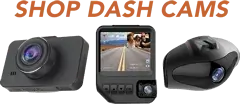
- 1.800.834.8669
- LIVE Chat Support
You have no items in your shopping cart.
Low Beam vs High Beam - Understanding Headlight Functions
What are low-beam headlights? What are high beams? Understanding the different headlight functions and how they work.
Last updated: August 22, 2023
All road vehicles come with two basic headline functions known as low beams (dims) and high beams (brights).
This applies to all vehicles from cars and SUVs to motorcycles, campers, and semi-trucks.
- Low beams (dims) are the primary source of light and most frequently used lighting function.
- High beams (brights) are a secondary source of light used occasionally in low light environments such as on dark country roads.

After reading this guide, you'll understand the differences between low beams and high beams, how they work, and when you should use them.
Low Beam vs High Beam Headlight Function
All cars have a low and high beam function and most drivers should already know the difference between the two since it's a prerequisite before getting your license!
The difference between low and high beams is that low beams are used for normal nighttime driving while high beams are used in rural areas or small roads with very little or no light at all.
Low beams are angled towards the road and must always be on at night or in low-light settings such as tunnels.
High beams are angled upwards for extra light and should only be used in very dark areas when there is no oncoming traffic so as to not blind other drivers.
High Beam vs Low Beam Comparison
| Beam | High | Low |
| Beam Angle | Straight/Upwards | Towards the ground/road |
| Focus | Long-range | Short-range |
| Light Coverage | ~100 meters (330 ft) | ~40 meters (130 ft) |
| Best For | Dark rural areas, small roads, etc. | Nighttime driving, tunnels, etc. |
| Activation Period | Very dark areas with no oncoming traffic or cars ahead | At night, tunnels, dim areas |
| Glare | High, will blind other drivers | No |
| Activation | Manual | Automatic or Manual |
| Legal? | Yes | Yes |
| Upgrade? | Can be upgraded to LED or HID | Can be upgraded to LED or HID |
What are Low Beams?
Low beams are the 'normal' lights your car headlights emit and are used when driving at night or in a dim/dark setting such as a tunnel or indoor parking lot.
Low beams have a short-range focus (40 meters) and are sometimes referred to as 'dipped beams' or dims. Low beams are the most important and most frequently used beam in a vehicle.
The light beam is angled towards the ground in order to illuminate the road without blinding other drivers. They are also a way for other drivers to see you.
When to Use Low Beam Headlights?
Low beams must be used at night (by law) and should be used during the day in low light environments such as tunnels and indoor parking lots.
It is required by law in the U.S. and Canada to have 2 functioning low-beam headlight bulbs at all times.
How to Use Low Beams?
Most vehicles on the road have automatic headlight systems, which turn on the low beams when a low light environment is detected.
Low beam headlights can be manually activated using the switch typically found on the turn signal lever.
What are High Beams?
The high beam headlight lighting function is normally activated in environments with no light such as the country roads with no street lights.
High beams have a long-range focus (100 meters) and are sometimes referred to as 'brights' or 'full beams'.
If you've ever seen someone flashing their headlights, those are the high beams. A small blue light will appear on your dashboard when they are activated.
The high beam light is angled upwards in order to illuminate a surface area above and beyond the light of the low beams. High beams have a long-range focus.
When to Use High Beam Headlights?
High beams should only be used for short periods of time when extra light is really needed to drive safely such as:
- Dark roads with no street lights
- Rural areas
- Poorly lit urban areas
Driving with your high beams will blind oncoming traffic, which can be very dangerous. Never keep your high beams on if there is a car in front of you and/or oncoming traffic.
High beam headlights must not be used within 500 feet of oncoming traffic or within 200-300 feet of vehicles ahead of you.
How to Use High Beams?
Unlike low beams, most high beams do not turn on automatically. They must be manually activated by the driver when needed.
To activate the high beams, you will need to pull or push the washer lever. Pulling the lever will temporarily activate the high beams while pushing it will keep them on until turned off.
Shopping for Headlight Bulbs
When shopping for new headlight, whether replacing your stock halogens or looking to upgrade to a brighter alternative such as LED headlights or Xenon HIDs, you will come across different bulbs for different beams.
A 2019 Ford F-150, for example, uses an H11 bulb for the low beams and a 9005 for the high beams. So, if one of your high beams goes out, it's important to know which bulb size you need for your specific beam.
Other vehicles, such as the 2021 Ford F-250, F-350, F-450, and F-550 use one H13 bulb for both low and high beam functions
Dual-Beam Headlight Systems
All cars and trucks come with a low beam and a high beam function, however, some cars use 2 separate bulbs for each beam (single beam systems) while others require only 1 bulb for both (dual beam systems).
Drivers that have cars with dual-beam systems will only need to buy one set of bulbs to replace (or upgrade) both low and high beams. Dual-beam bulbs are typically slightly more expensive than single-beam bulbs and draw more power.
To learn more on these two types of headlight bulb systems check out our guide on Single Beam vs. Dual Beam Headlight Bulbs.
Frequently Asked Questions:
High beams need to be manually activated using the blinker or washer lever depending on the vehicle.
Pulling the lever will temporarily keep them on as long as the lever is manually held back.
Pushing the lever will leave them on until the lever is repositioned to its neutral state.
This entirely depends on your car.
Some cars happen to use the same bulb size for each of the high and low beams in a single-beam system while others use completely different bulb sizes.
In the event that they are the same, you will need two sets of bulbs, one set for your lows and another for your high beams.
No. High beams will produce a greater amount of light simply due to the angle and position within the headlight.
For that reason, the high beams will always appear brighter, even though the bulbs themselves may be equally as bright outside of the headlight.
Yes. Using your high beams is legal but should not be used continuously as they blind other drivers.
High beam usage should be restricted to very dark environments with no oncoming traffic or vehicles ahead.
None. Brights is just another term used for high beams and originates from the extra brightness produced by the high beam.
Yes but only at night. Using your high beams in such weather conditions during the day will cause the light to reflect back at you making it harder to see.
Yes but only in certain newer cars.
Automatic high beams is a new technology that works using a sensor and a forward-facing camera.
The sensor detects low light levels while the camera detects oncoming traffic in order to dim the lights and prevent blinding other drivers.
No. Fog lights are a separate beam, only come on certain cars, and are not required by law.
Fog lights are typically found in the front bumper of a car or truck in their own separate assembly.
Low beams and high beams are found in your car's headlight assembly which typically sits on top of your front bumper.
Sources:
- XenonPro.com Research
- Few drivers use their high beams, study finds - IIHS
- When Should High Beam Headlights Be Used? - Driving Tests
- High-Beam Intensity, Visual Performance and Safety-Related Impacts - Lighting Research Center
- Impacts of Various High Beam Headlight Intensities on Driver Visibility and Road Safety - Journal of the Society of Automotive Engineers
Disclaimer: The information contained on this page is provided free of charge to our visitors. It was prepared to the best of our abilities and with all the information available to us at the time of writing. We reserve the right to change, remove or update any information contained on this page at any time and without notice to improve its accuracy. The most reliable method to determine the bulb size is by pulling your actual bulb(s) and reading the part number indicated directly on the bulb. The information compiled on this page comes with no guarantees or warranties.





















